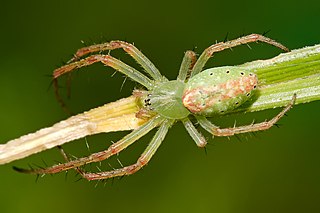
Cyrtophora, the tent-web spiders, is a genus of orb-weaver spiders first described by Eugène Simon in 1895. Although they are in the "orb weaver" family, they do not build orb webs. Their tent-like, highly complex non-sticky web is sometimes considered a precursor of the simplified orb web. These webs are aligned horizontally, with a network of supporting threads above them. These spiders often live in colonies. Females have a body length of mostly about 10 millimetres (0.39 in) long. Some members, including Cyrtophora cicatrosa, exhibit the ability to change colour rapidly.
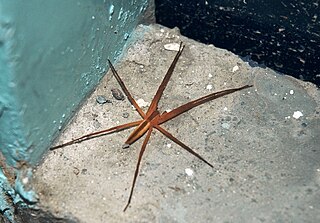
Nilus albocinctus, synonym Thalassius albocinctus, commonly called the fishing spider, is a species of spider found in tropical Asia from India to the Philippines. It is named after its habit of catching small fish. The spider is striking in appearance and can be easily recognised by the presence of a black, glossy, broad median band bordered by a white lateral band on the cephalothorax and abdomen. The legs are long and yellowish brown. It is usually found near water.

Gasteracantha sturi, commonly known as the blunt-spined kite spider, is a species of spider belonging to the family Araneidae. It is found in Southeast Asia, from Laos to the Moluccas.

Argiope catenulata, also known as the grass cross spider, is a species of orb-weaver spiders ranging from India to the Philippines and Papua New Guinea, and also found in Australia in 2019. Like other species of the same genus, it builds a web with a zig-zag stabilimentum.
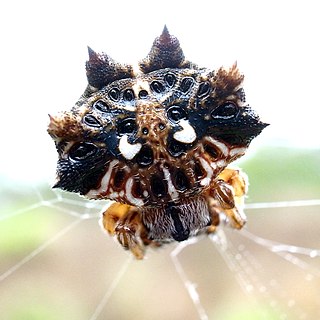
Thelacantha is a genus of orb-weaver spiders containing the single species, Thelacantha brevispina. It was first described by A. W. M. van Hasselt in 1882, and has been found in Australia, Madagascar, and across southern Asia from India to Philippines, including Japan. It has also been introduced into Hawaii. T. brevispina is closely related those in the genus Gasteracantha, and was briefly synonymized with it in 1859, but revalidated in 1974. Saito described three other Thelacantha species in 1933, which were later synonymized with T. brevispina.

Cyrtarachne is a genus of orb-weaver spiders first described by Tamerlan Thorell in 1868.
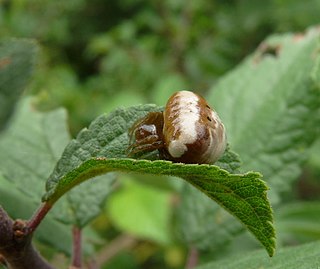
Cyrtarachne ixoides is an orb-weaver spider species found in the Mediterranean basin to Georgia and also in Madagascar.

Hypsosinga albovittata is an orb-weaver spider species, found in the Palearctic.
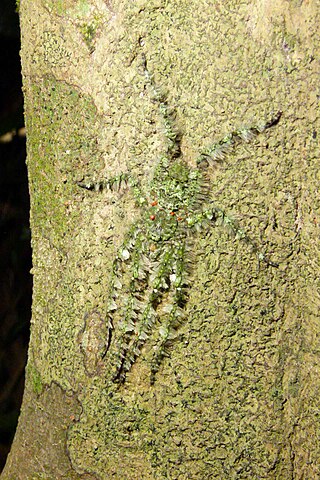
Pandercetes is a genus of huntsman spiders that was first described by Ludwig Carl Christian Koch in his 1875 treatise on Australian spiders. They are mainly distributed in tropical Asia and Australia, and are known for their cryptic coloration that matches local moss and lichen. Their legs have lateral hairs, giving them a feathery appearance, further masking their outline against tree trunks. Their head is somewhat elevated and the carapace has the thoracic region low and flat.
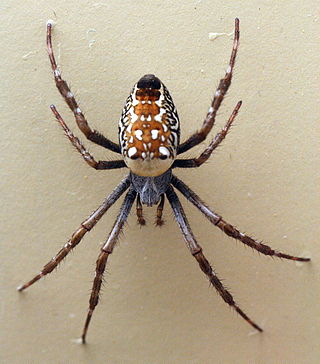
Cyrtophora moluccensis is a tent-web spider in the orb-weaver family. It is commonly known as the tent spider or dome-web spider, and is native to India, Japan, Indonesia, Papua New Guinea, Australia, Fiji, and Tonga. It is often found in disturbed or open habitats from coasts to forest and mountainous interiors.
Araneus arizonensis is a species of spider in the family Araneidae, found in United States and Mexico.
Araneus enucleatus is a species of spider of the genus Araneus. It is found in India, Sri Lanka, Myanmar and Sumatra.
Cyrtarachne raniceps is a species of spider of the genus Cyrtarachne. It is found in India and Sri Lanka. It is 9 mm long and has brown carapace with a heart shaped sternum.

Cyrtophora unicolor is a species of spider of the family Araneidae. It is known as the red tent spider.
Glyptogona duriuscula, is a species of spider of the genus Glyptogona. It is endemic to Sri Lanka.
Hypsosinga taprobanica, is a species of spider of the genus Hypsosinga. It is endemic to Sri Lanka.
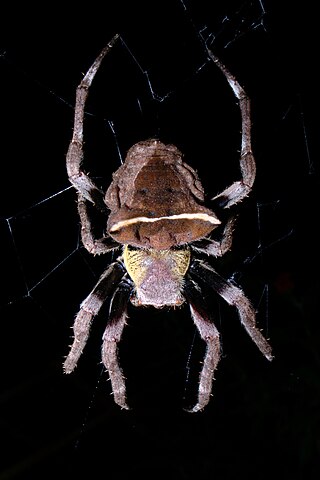
Parawixia dehaani, known in Australia as the abandoned-web orb-weaver, is a species of orb weaver spider from the family Araneidae which is widely distributed in Australasia and eastern Asia. It is common in gardens, leading to it sometimes being known by the name common garden spider. The specific name is sometimes spelt dehaanii.

Cyrtarachne inaequalis is a species of spider in the orb-weaver spider family Araneidae, found in India, Myanmar, China and Korea. Spiders in the genus Cyrtarachne construct "spanning-thread webs" rather than the more typical orb webs of the family Araneidae. These webs have a small number of radii and instead of a tight spiral of sticky threads, the sticky spanning threads are widely spaced and do not form a spiral. When prey is caught on one of the spanning threads, one end comes loose, and the prey, often a moth, dangles from the other end until hauled in by the spider.

Cyrtarachne nagasakiensis is a species of spider in the orb-weaver spider family Araneidae, found in Pakistan, India, China, Korea and Japan. Spiders in the genus Cyrtarachne construct "spanning-thread webs" rather than the more typical orb webs of the family Araneidae. These webs have a small number of radii and instead of a tight spiral of sticky threads, the sticky spanning threads are widely spaced and do not form a spiral. When prey is caught on one of the spanning threads, one end comes loose, and the prey, often a moth, dangles from the other end until hauled in by the spider.

Cyrtarachne yunoharuensis is a species of spider in the orb-weaver spider family Araneidae, found in China, Korea and Japan. Spiders in the genus Cyrtarachne construct "spanning-thread webs" rather than the more typical orb webs of the family Araneidae. These webs have a small number of radii and instead of a tight spiral of sticky threads, the sticky spanning threads are widely spaced and do not form a spiral. When prey is caught on one of the spanning threads, one end comes loose, and the prey, often a moth, dangles from the other end until hauled in by the spider.













